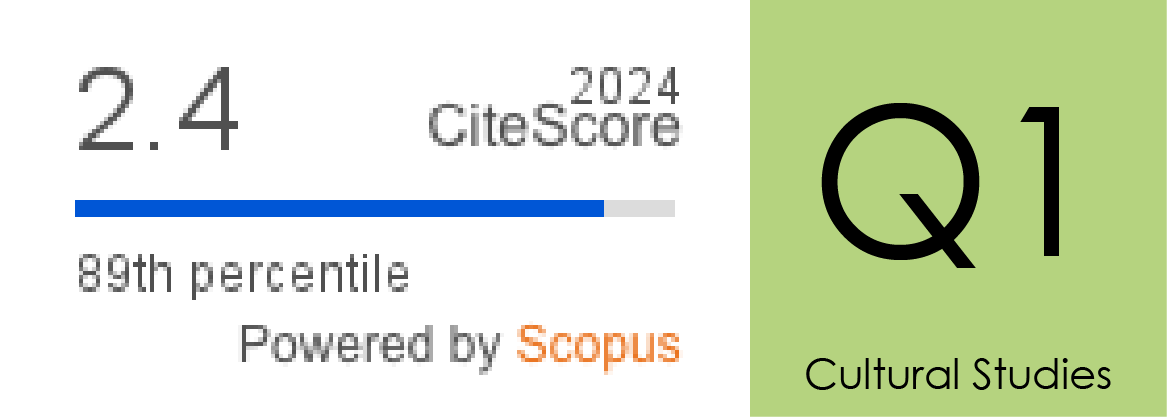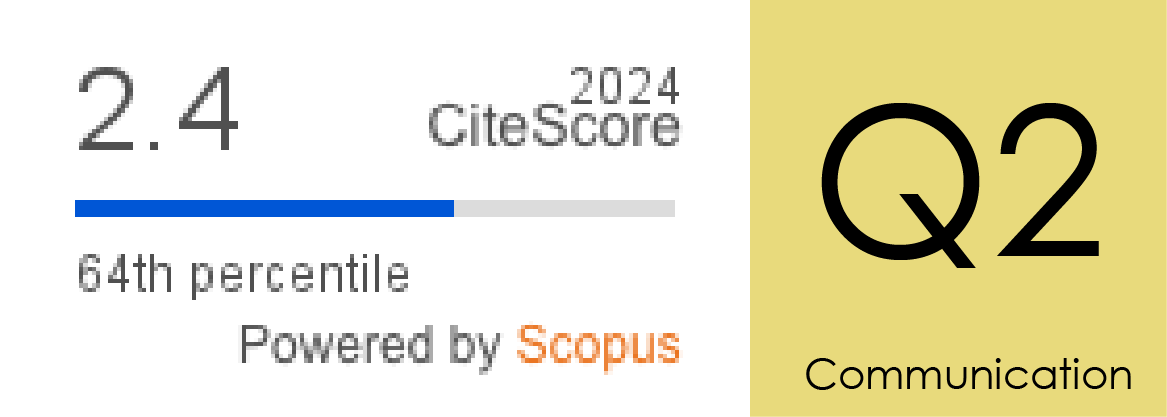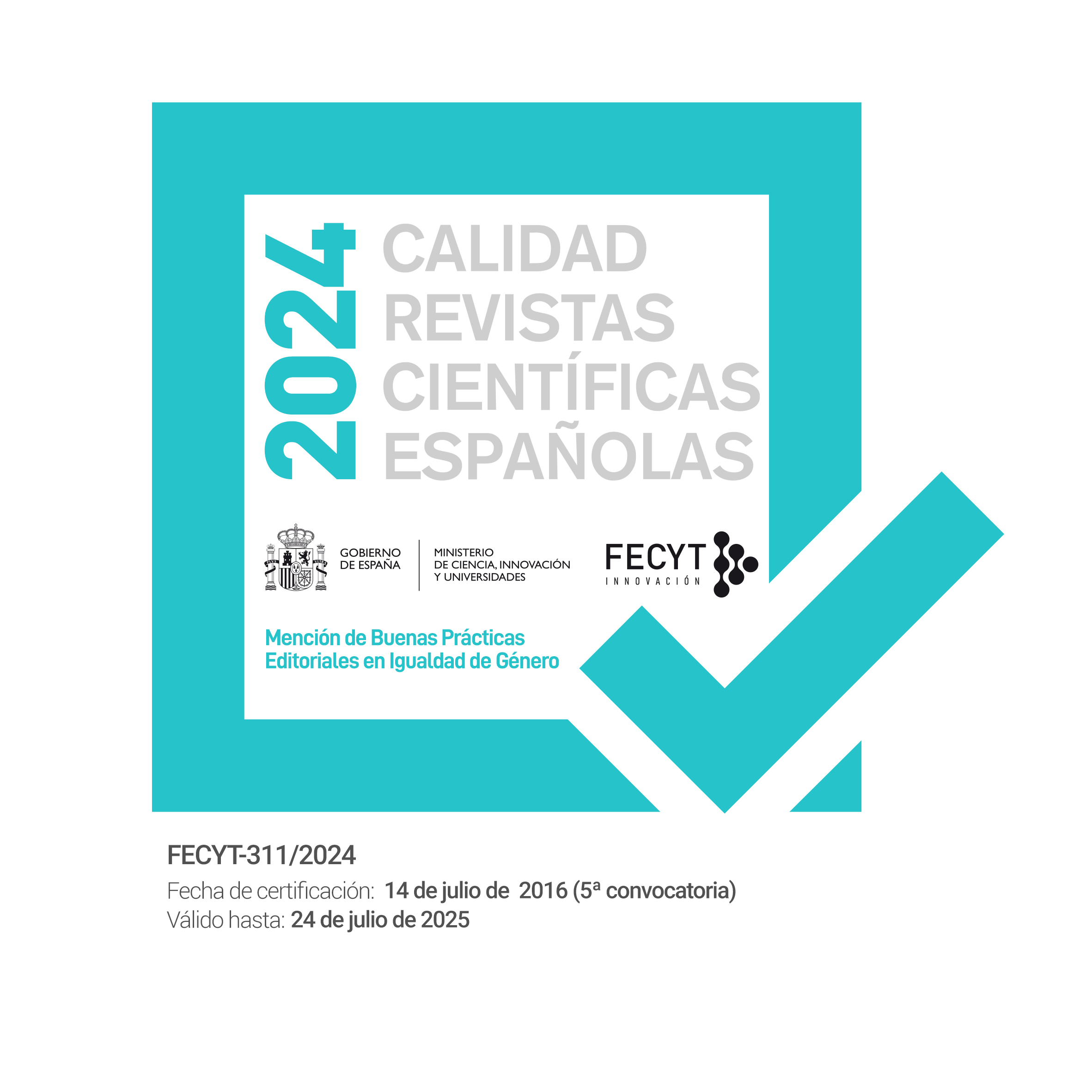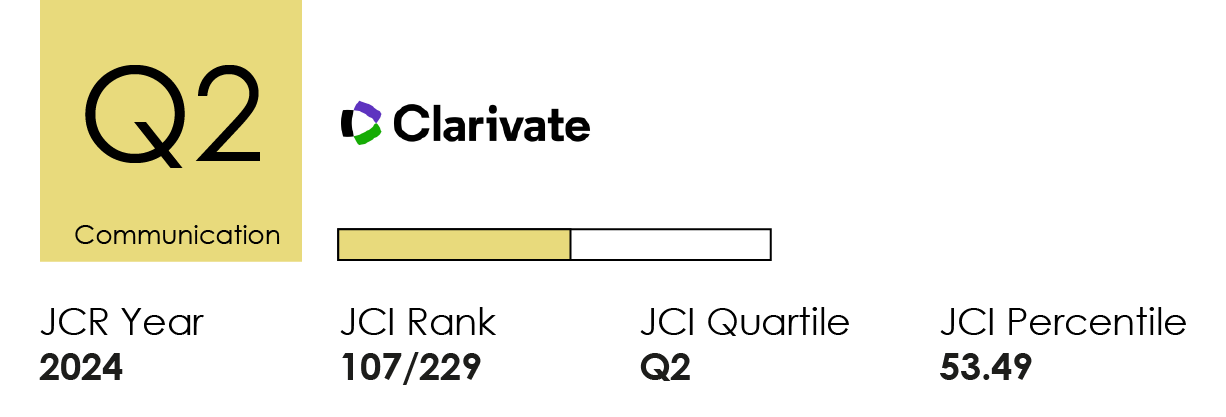La imagen importa entre la Gen Z: Creatividad y eficacia en el rebranding de la radiotelevisión pública catalana
DOI:
https://doi.org/10.14198/MEDCOM.30354Palabras clave:
Identidad visual, Rebranding, Diseño gráfico, Medios de servicio público, Radiotelevisión pública, TV3, 3Cat, Audiencias jóvenes, Generación Z, Gen ZResumen
Propósito: Evaluar la eficacia del rebranding de la
radiotelevisión pública catalana tras el cambio de
identidad de TV3 y Catalunya Ràdio a 3Cat, focalizando
en la percepción de valores, asociaciones de marca y
aumento en el consumo de contenidos entre jóvenes y
jóvenes-adultos de 18 a 34 años. Metodología: Se
realizó un estudio cuantitativo mediante una muestra de
348 jóvenes residentes en Cataluña, recogida durante el
primer cuatrimestre de 2025, para analizar atributos,
asociaciones y valoración del nuevo diseño gráfico.
Resultados y conclusiones: Los resultados indican que
el rebranding ha reforzado la imagen de proximidad,
modernidad y compromiso lingüístico de la marca con el
catalán y aumentado el consumo entre los jóvenes que
ya veían TV3. Sin embargo, la coincidencia con el
lanzamiento de la plataforma on demand dificulta aislar el
impacto exclusivo del cambio de identidad visual.
Aportación original: Este estudio aporta evidencia
empírica sobre el papel del rediseño de la identidad
visual de un medio de comunicación público en la
conexión con audiencias jóvenes en un entorno
mediático fragmentado, ofreciendo insights valiosos para
la estrategia de branding en medios públicos.
Citas
Aaker, David (1991). Managing brand equity. Free Press.
Aaker, David & Keller, Kevin (1990). Consumer Evaluations of Brand Extensions, Journal of Marketing, 54(1), 27–41. https://doi.org/10.1177/002224299005400102
Autenrieth, Ulla, Künzler, Matthias, & Fehlmann, Fiona (2021). Shoulda, Coulda, Woulda’: Young Swiss audiences’ attitudes, expectations and evaluations of audiovisual news and information content and the implications for public service television. Critical Studies in Television, 16(2), 110-125. https://doi-org.sire.ub.edu/10.1177/1749602021998238
Azurmendi, Ana (2018). Reconnecting with young audiences: transmedia storytelling to transform public service television in Spain, France, Germany and the United Kingdom. Revista Latina de Comunicación Social, 73, 927-944. https://doi.org/10.4185/RLCS-2018-1289
Balmer, John (1994). The BBC's Corporate Identity: Myth, Paradox and Reality, Journal of General Management, 19(3), 33-49. https://doi.org/10.1177/030630709401900303
Barnard, Malcolm (2005). Graphic Design as Communication (1st ed.). Routledge. https://doi.org/10.4324/9781315015385
Beverland, Michael, Eckhardt, Giana, & Sean, Avi (2020). How brands craft national identity. Journal of Consumer Research, 42(5), 903–925. https://doi.org/10.1093/jcr/ucaa062
Bigné‐Alcañiz, Enrique, Currás‐Pérez, Rafael, y Sánchez‐García, Isabel (2009). Brand credibility in cause‐related marketing: the moderating role of consumer values, Journal of Product & Brand Management, 18(6), 437-447. https://doi.org/10.1108/10610420910989758
Billard, Thomas (2016). Fonts of potential: Areas for typographic research in political communication. International Journal of Communication, 10, 4570–4592.
Bonales-Daimiel, Gema, Mañas-Viniegra, Luis, y Jiménez-Gómez, Isidro (2021). El impacto del flat design en el reconocimiento de marcas automovilísticas. Grafica, 9(18), 105-113. https://doi.org/10.5565/rev/grafica.205
Bontour, Anne, & Lehu, Jean-Marc (2002). Lifting de Marques. Editions d'Organisation.
Bottomley, Paul & Doyle, John (2006). The interactive effects of colors and products on perceptions of brand logo appropriateness. Marketing Theory, 6(1), 63-83. https://doi.org/10.1177/1470593106061263
CCMA. (2025). Manual d'identitat 3Cat. Recuperado de https://my.corebook.io/3Cat/introduccio?m=4888460
Ceballos-del-Cid, Yaiza, Gómez-Calderón, Bernardo, y Córdoba-Cabús, Alba (2025). Redes sociales y hábitos de consumo informativo de los jóvenes españoles: un análisis diacrónico (2021-2023). Revista Mediterránea de Comunicación, 16(1), 263-276. https://doi.org/10.14198/MEDCOM.28010
Chan-Olmsted, Sylvia, & Yungwook, Kim (2001). Perceptions of Branding among Television Station Managers: An Exploratory Analysis. Journal of Broadcasting & Electronic Media, 45(1), 75–91. https://doi.org/10.1207/s15506878jobem4501_6
Chan-Olmsted, Sylvia, & Yungwook, Kim (2002). The PBS brand versus cable brands: Assessing the brand image of public television in a multichannel environment. Journal of broadcasting & electronic media, 46(2), 300-320. https://doi.org/10.1207/s15506878jobem4602_8
Chan-Olmsted, Sylvia (2011). Media Branding in a Changing World: Challenges and Opportunities 2.0. International Journal on Media Management, 13(1), 3–19. https://doi.org/10.1080/14241277.2011.568305
Coll, Bernat (2024, 3 de mayo). “El catalán busca hablantes: es minoritario en las redes y se usa cada vez menos en Barcelona”. El País. https://elpais.com/espana/elecciones-catalanas/2024-05-03/al-rescate-del-catalan-sin-presencia-audiovisual-una-generacion-ha-crecido-sin-referentes.html
Collins, Leslie (1977). A Name to Compare With A Discussion of the Naming of New Brands, European Journal of Marketing, 11(5), 337-363. https://doi.org/10.1108/EUM0000000005020
Constitución Española (1978). Constitución Española (BOE núm. 311, de 29 de diciembre de 1978). https://www.boe.es/buscar/act.php?id=BOE-A-1978-31229
Comscore. (2024). Comscore MMX Multiplataforma [Informe]. https://www.comscore.com/
Crusafón, Carmina, González-Saavedra, Carlos, y Murciano, Marcial (2020). Televisión pública en España y jóvenes universitarios: radiografía del acceso, consumo y valores más preciados. En: Comunicación y diversidad. Selección de comunicaciones del VII Congreso Internacional de la Asociación Española de Investigación de la Comunicación (AE-IC). Valencia, España, 28-30 de octubre, 357-366.
Dlamini, Lucky-Briand & Daniels, Glenda (2022). Scrutinising South African media companies’ strategies for Generation Z’s news consumption. Media, Culture & Society, 45(4), 702-719. http://dx.doi.org/10.1177/01634437221135979
Donders, Karen (2019). Public Service Media Beyond the Digital Hype: Distribution strategies in a platform era. Media, Culture & Society, 41(7), 1011-1028. https://doi.org/10.1177/0163443719857616
Dragomir, Marius & Túñez-López, Miguel (2024). How public service media are changing in the platform era: A comparative study across four European countries. European Journal of Communication, 39(6), 608-624. https://doi.org/10.1177/02673231241290062
Durán, Iván (2018). Television and electoral results in Catalonia. SERIEs 9, 423–456. https://doi.org/10.1007/s13209-018-0183-3
Elías-Zambrano, Rodrigo y Jiménez-Marín, Gloria (2024). Contexto artístico de la publicidad. La intertextualidad en la dirección de arte. EUS (Editorial Universidad de Sevilla).
Eguzkitza-Mestraitua, Gaizka, Guimerà-i-Orts, Josep Àngel, y Casado-del-Río, Miguel Angel (2023). Are there any young people out there? Spanish public broadcaster in search of new audiences. Catalan journal of communication & cultural studies, 15(1), 123-142. http://dx.doi.org/10.1386/cjcs_00081_1
Erjansola Ari-Matti, Lipponen Jukka, Vehkalahti Kimmo, Aula, Hanna-Mari, & Pirttilä-Backman, Maija (2021). From the brand logo to brand associations and the corporate identity: visual and identity-based logo associations in a university merger. Journal of Brand Management, 28, 241-253. https://doi.org/10.1057/s41262-020-00223-5
Fernández-Muñoz, Cristóbal, Rubio-Moraga, Ángel Luis, y Álvarez-Rivas, David (2024). La Generación Z frente a la desinformación: percepciones y prácticas en la era digital. Estudios sobre el Mensaje Periodístico, 30(3), 517-529. https://doi.org/10.5209/emp.96511
Fieiras-Ceide, César, Túñez-López, Miguel, y Pedro-Sousa, Jorge (2023). Radiografía de innovación de los medios públicos de escala nacional de la península Ibérica: visión estratégica, tecnológica, y de captación de audiencias jóvenes en RTVE y RTP. Revista Latina de Comunicación Social, 81, 353-374. https://www.doi.org/10.4185/RLCS-2023-1957
Fondevila-Gascón, Joan Francesc, Mir-Bernal, Pedro, Sádaba-Garraza, Teresa, y Vila-Márquez, Fátima (2023). Moda o ¿cómo interactuar con las generaciones jóvenes para crear marca? Cuadernos del Centro de Estudios en Diseño y Comunicación, 24. https://doi.org/10.18682/cdc.vi150.5534
Frigolé, Joan (2014). Retóricas de la autenticidad en el capitalismo avanzado. Éndoxa: Series Filosóficas, 33, 37-60. https://www.doi.org/10.5944/endoxa.33.2014.13564
Garg, Vaishali & Mishra, Abhishek (2025). Redefining rebranding: identity–image dynamics, Journal of Indian Business Research, 17(2), 111-134. https://doi.org/10.1108/JIBR-06-2024-0151
García-Avilés, José, Kaltenbrunner, Andy, & Meier, Klaus (2014). Media Convergence Revisited: Lessons learned on newsroom integration in Austria, Germany and Spain. Journalism Practice, 8(5), 573–584. https://doi.org/10.1080/17512786.2014.885678
Gfk. (2025). GfK. Panel de audiencia [Informe]. https://www.gfk-media-measurement.com/
Gómez-de-Travesedo-Rojas, Ruth y Gil-Ramírez, Marta. (2020). Generación Z y consumo de información política: entre la televisión y los nuevos formatos mediáticos. Ámbitos. Revista Internacional De Comunicación, 50, 62–79. https://doi.org/10.12795/Ambitos.2020.i50.05
González-Neira, Ana, Quintas-Froufe, Natalia, y Scaglioni, Massimo (2023). El virus en la pantalla: hábitos de consumo de la audiencia televisiva en España e Italia (2019-2022). Revista Mediterránea de Comunicación, 14(1), 19-35. https://www.doi.org/10.14198/MEDCOM.23463
Gutiérrez, Alex (2015, 26 de septiembre). “TV3: història d’una depuració gràfica”. El País. https://www.ara.cat/media/tv3-historia-duna-depuracio-grafica_129_3046804.html
Gwinner, Kevin & Eaton, John (1999), Building brand image through event sponsorship: the role of image transfer, Journal of Advertising, 28(4), 47-57. https://doi.org/10.1080/00913367.1999.10673595
Haenschen, Katherine & Tamul, Daniel (2020). What’s in a font?: Ideological perceptions of typography. Communication Studies, 71(2), 244–261. https://doi.org/10.1080/10510974.2019.1692884
Haenschen, Katherine, Tamul, Daniel, & Collier, Jessica (2021). Font Matters: Understanding Typeface Selection by Political Campaigns. International Journal of Communication, 15, 21. https://ijoc.org/index.php/ijoc/article/view/17615/3475
Henderson, Pamela & Cote, Joseph (1998). Guidelines for Selecting or Modifying Logos. Journal of Marketing, 62(2), 14-30. https://doi.org/10.1177/002224299806200202
Hidalgo-Marí, Tatiana y Segarra-Saavedra, Jesús. (2017). La presencia de la televisión pública española en redes sociales. Estudio de caso de las televisiones nacionales y autonómicas en los social media. En En Castelló-Martínez, Araceli, Pino-Romero, Cristina del (coords.), Publicidad y convergencia mediática: nuevas estrategias de comunicación persuasiva (pp. 28-41). Egregius Ediciones.
Hidalgo-Marí, T. y Segarra-Saavedra, J. (2018). La estrategia de branding creativo como ejemplo de perdurabilidad de la marca: El caso de Tiffany&Co. En V. Tur-Viñes; I. García-Medina y T. Hidalgo-Marí (Coords.), Creative Industries Global Conference. Libro de actas (pp. 49-59). Alicante: Colección Mundo Digital de Revista Mediterránea de Comunicación. Universidad de Alicante. http://www.doi.org/10.14198/MEDCOM/2017/12_cmd
Howe, Neil & Strauss, William (2007). The Next 20 Years: How Customer and Workforce Attitudes Will Evolve. Harvard Business Review. https://hbr.org/2007/07/the-next-20-years-how-customer-and-workforce-attitudes-will-evolve
Idescat. (2024). EP: Estimaciones de población. https://www.idescat.cat/pub/?id=ep&lang=es
Jim-Wu, Yen-Chun (2009). Renaming effect of brand value: state‐owned enterprises, Management Decision, 47(10), 1555-1581. https://doi.org/10.1108/00251740911004682
Johnson, Sammye & Prijatel, Patricia (2013). The Magazine from Cover to Cover: Inside a Dynamic Industry. Oxford University Press.
Kantar Media. (2024). Audiencias televisión 2024 [Informe]. https://www.kantar.com
Kantar Media. (2025). Audiencias televisión 2025 [Informe]. https://www.kantar.com
Kantar Media. (2025). Cross Platform View [Informe]. https://www.kantar.com
Keller, Kevin (1993). Conceptualizing, measuring, and managing customer-based brand equity. Journal of Marketing, 57(1), 1-22. https://doi.org/10.1177/002224299305700101
Keller, Kevin (2003). Brand synthesis: The multidimensionality of brand knowledge. Journal of Consumer Research, 29(4), 595-600. https://doi.org/10.1086/346254
Kvale, Steiner (2008). Doing Interviews. SAGE Publications.
Luffarelli, Jonathan, Stamatogiannakis, Antonios, & Yang, Haiyang (2019). The Visual Asymmetry Effect: An Interplay of Logo Design and Brand Personality on Brand Equity. Journal of Marketing Research, 56(1), 89-103. https://doi.org/10.1177/0022243718820548
Machado, Joana, Vacas de Carvalho, Leonor, Torres, Anna, & Costa, Patrício (2015). Brand logo design: examining consumer response to naturalness. Journal of Product & Brand Management, 24(1), 78-87. https://doi.org/10.1108/JPBM-05-2014-0609
Mañas-Viniegra, Luis, Santos-Silva, Dora, & Liberal-Ormaechea, Sheila (2020). The Visual-Digital Identity of Corporate Brands: A Study of Neuromarketing in Young People from Spain and Portugal. Trípodos, 48, pp.135-151
Marugán-Solís, Fernando y Martín-Critikián, Davinia (2023). Redes sociales y Generación Z. Doxa Comunicación. Revista Interdisciplinar de Estudios de Comunicación y Ciencias Sociales, 36, 381-399. https://doi.org/10.31921/doxacom.n36a1707
Melewar, Gareth & Srivoravilai, Noporn (2005). Corporate visual identity: the re-branding of France Télécom. Brand Manage, 12(5), 379–94. http://dx.doi.org/10.1057/palgrave.bm.2540233
Melina, Magdalena & Muhlhausler, Peter (2007). Lexical developments in greenspeaking. Topics in English Linguistics 54. https://doi.org/10.1515/9783110197860.275
Müller, Brigitte, Kocher, Bruno, & Crettaz, Antoine (2011). The effects of visual rejuvenation through brand logos. Journal of Business Research, 66(1), 82-88. https://doi.org/10.1016/j.jbusres.2011.07.026
Muzellec, Laurent, Doogan, Manus, & Lambkin, Mary (2003). Corporate rebranding-an exploratory review. Irish Marketing Review, 16(2), 31-40.
Muzellec, Laurent & Lambkin, Mary (2006). Corporate rebranding: Destroying, transferring or creating brand equity? European Journal of Marketing, 40(7/8), 803-824. https://doi.org/10.1108/03090560610670007
McQuinston, Laszlo (1993). Graphic Agitation. Social and Political Graphics since the Sixties. Phaidon Press.
McQuinston, Laszlo (2004). Graphic Agitation 2. Social and Political Graphics in the Digital Age. Phaidon Press
Napoli, Philip (2011). Audience Evolution: New Technologies and the Transformation of Media Audiences. Columbia University Press.
Nikpour, Noelle (2012). Branding America: What Does YOUR Brand Say About You?. CreateSpace Independent Publishing Platform.
Ofcom. (2023). Online Nation 2023 report. https://www.ofcom.org.uk/siteassets/resources/documents/research-and-data/online-research/online-nation/2023/online-nation-2023-report.pdf?v=368355
Peng, Luluo, Wei, Yuting, Zhang, Xiaodan, & Wang, Danping (2024). Flatness promotes modernity: logo flatness and consumers' perception of brand image, Asia Pacific Journal of Marketing and Logistics, 36(2), 315-333. https://doi.org/10.1108/APJML-02-2023-0111
Pentina, Iryna, Guilloux, Véronique, & Micu, Anca (2018). Exploring Social Media Engagement Behaviors in the Context of Luxury Brands. Journal of Advertising, 47(1), 55–69. https://doi.org/10.1080/00913367.2017.1405756
Pittard, Narelle, Ewing, Michael, & Jevons, Colin (2007). Aesthetic theory and logo design: examining consumer response to proportion across culture. International Marketing Review, 24(4), 457–473. https://doi.org/10.1108/02651330710761026
Plataforma per la Llengua. (2024). InformeCAT 2024: 50 dades sobre l’estat del català [Informe anual]. Plataforma per la Llengua.
Plummer, Joseph T. (1990). Outliving the myths. Journal of Advertising Research 30.1 26-28.
Pogacar, Ruth, Angle, Justin, Lowrey, Tina M., Shrum, L. J., & Kardes, Frank R. (2021). Is Nestlé a Lady? The Feminine Brand Name Advantage. Journal of Marketing, 85(6), 101-117. https://doi.org/10.1177/0022242921993060
Prieto-Arosa, Juan Manuel & d’Haenens, Leen (2025). Bridging youth ‘media egocentrism’ and journalistic values: strategies for public service media. Frontiers in Communication, 10:1534133. https://doi.org/10.3389/fcomm.2025.1534133
Real Rodríguez E., Príncipe Hermoso S. y Agudiez Calvo P. (2024). La transformación digital de la televisión pública. Estudio de caso de RTVE, Rai y RTP. Estudios sobre el Mensaje Periodístico, 30(1), 211-221. https://doi.org/10.5209/esmp.91920
Reiter, Gisela, Gonser, Nicole, Grammel, Marcus, & Gründl, Johann (2018). Young Audiences and Their Valuation of Public Service Media. In: Ferrell Lowe, G, van den Bulck, H and Donders, Karen (eds) Public Service Media in the Networked Society (pp. 211–226). Nordicom,.
Reysen, Stephen, Snider, Jamie, & Branscombe, Nyla (2012). Corporate Renaming of Stadiums, Team Identification, and Threat to Distinctiveness. Journal of Sport Management, 26(4), 350-357. Retrieved Jun 26, 2025, from https://doi.org/10.1123/jsm.26.4.350
Roedder-John, Deborah, Loken, Barbara, Kyeongheui, Kim, & Monga, Alokparna-Basu (2006). Brand Concept Maps: A Methodology for Identifying Brand Association Networks. Journal of Marketing Research, 43(4), 549-563. https://doi.org/10.1509/jmkr.43.4.549
Sánchez-Iranzo, Marta (2025, 3 de junio). 3Cat, tercera plataforma preferida por los catalanes detrás de Prime Video y Netflix. El Nacional. https://www.elnacional.cat/es/sociedad/3Cat-tercera-plataforma-mas-consumida-por-catalanes-detras-prime-video-netflix_1427983_102.html
Seidman, Steven (2010). Barack Obama’s 2008 Campaign for the U.S. Presidency and Visual Design. Journal of Visual Literacy, 29(1), 1–27. https://doi.org/10.1080/23796529.2010.11674671
Serrat, Jordi (2021). Vots al carrer l’1 d’octubre de 2017 a Catalunya: la ‘fake news’ menys aclarida. Tripodos, (44), 153–168. https://doi.org/10.51698/tripodos.2019.44p153-168
Schulz, Anne, Levy, David, & Kleis-Nielsen, Rasmus (2019). Old, Educated and Politically Diverse: The Audience of Public Service News. Oxford: Reuters Institute for the Study of Journalism.
Shuy, Roger (2002). The Meaning of a Patronymic Prefix. In: Linguistic Battles in Trademark Disputes. Palgrave Macmillan. https://doi.org/10.1057/9780230554757_8
Van Dijck, Jose & Poell, Thomas (2014). Making Public Television Social? Public Service Broadcasting and the Challenges of Social Media. Television & New Media, 16(2), 148-164. https://doi.org/10.1177/1527476414527136
Vliegenthart, Rens (2011). The Professionalization of Political Communication? A Longitudinal Analysis of Dutch Election Campaign Posters. American Behavioral Scientist, 56(2), 135-150. https://doi.org/10.1177/0002764211419488
Webster, James & Ksiazek, Thomas (2012). The Dynamics of Audience Fragmentation: Public Attention in an Age of Digital Media. Journal of Communication, 62(1), 39-56. https://doi.org/10.1111/j.1460-2466.2011.01616.x
Zalduendo, María Rosario (2007). Ficción televisiva y construcción de identidad cultural: el caso catalán. Opción: Revista de Ciencias Humanas y Sociales 52, 61-71. https://produccioncientificaluz.org/index.php/opcion/article/view/6399
Descargas
Publicado
Cómo citar
Número
Sección
Licencia
Derechos de autor 2018 Fátima Vila-Márquez, Ramón Martín-Guart, Jordi Botey-López, Josep Llados-Used

Esta obra está bajo una licencia internacional Creative Commons Atribución 4.0.
Los autores y autoras que publican en esta revista están de acuerdo con los siguientes términos:
1 Derechos de autor. Los autores y autoras conservan sus derechos de autor, aunque ceden a la revista de forma no exclusiva los derechos de explotación (reproducción, distribución, comunicación pública y transformación) y garantizan a esta el derecho de primera publicación de su trabajo, el cual estará simultáneamente sujeto a la licencia indicada en punto 2. Los autores pueden establecer otros acuerdos adicionales para la distribución no exclusiva de la versión de la obra publicada en la revista, siempre que exista un reconocimiento de su publicación inicial en esta revista.
© Los autores.
2 Licencia. Los trabajos se publican en la revista sujetos a la licencia de Reconocimiento 4.0 Internacional de Creative Commons (CC BY 4.0); los términos se pueden consultar en https://creativecommons.org/licenses/by/4.0/
Esta licencia permite a terceros compartir (copiar y redistribuir el material en cualquier medio o formato) y adaptar (remezclar, transformar y crear a partir del material para cualquier finalidad, incluso comercial), siempre que se reconozca la autoría y la primera publicación en esta revista (Revista Mediterránea de Comunicación (RMC) / Mediterranean Journal of Communication (MJC), Universidad de Alicante, DOI de la obra), se proporcione un enlace a la licencia y se indique si se han realizado cambios en la obra.
3 Política de autoarchivo. Se recomienda a los autores que difundan sus trabajos a través de Internet para favorecer una circulación y difusión más rápidas y, con ello, un posible aumento en la citación y alcance entre la comunidad científica y académica, en las siguientes condiciones:
No se permite a los autores depositar en un repositorio institucional o temático, página web propia, etc., las versiones preprint (versión antes de ser evaluada) o postprint (versión evaluada y aceptada para su publicación) de sus trabajos antes de su publicación, pero sí el artículo final publicado (versión del editor).













